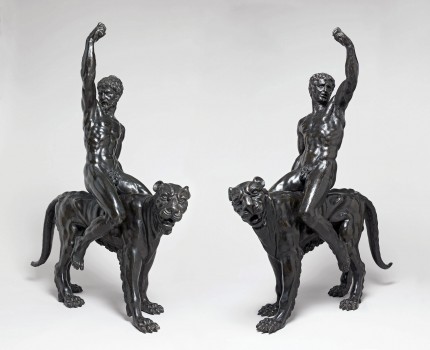
A pair of bronze statuettes known as the Rothschild Bronzes have been attributed to Michelangelo by an international team of multi-disciplinary experts at the University of Cambridge’s Fitzwilliam Museum. The bronzes are 16 inches wide by 2 feet 7.5 inches high and depict heroic male nudes riding panthers, likely a Bacchic procession theme. They are not a matched pair — one of the men is a bearded mature figure, the other a clean-faced youth — but they are part of a set. If the attribution is accurate, these statues will be the only known surviving bronzes by a sculptor whose works in marble have become icons of Western art.
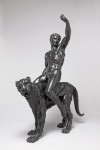 As always in cases of disputed authorship, conclusive evidence is hard to come by and these bronzes have already been attributed to a variety of artists known and unknown. The Rothschild Bronzes are so named because they were first recorded in the art collection of Swiss banker Baron Adolphe de Rothschild published in 1878. The works were attributed to Michelangelo at that time, but it was immediately disputed. The undeniably high quality of the bronzes and their style pointed to a 16th century Italian Renaissance origin. With no signature or mark that could resolve the issue, other possible authors like sculptor and architect Jacopo Sansovino and Tiziano Aspetti, known particularly for his bronze sculptures, were mooted.
As always in cases of disputed authorship, conclusive evidence is hard to come by and these bronzes have already been attributed to a variety of artists known and unknown. The Rothschild Bronzes are so named because they were first recorded in the art collection of Swiss banker Baron Adolphe de Rothschild published in 1878. The works were attributed to Michelangelo at that time, but it was immediately disputed. The undeniably high quality of the bronzes and their style pointed to a 16th century Italian Renaissance origin. With no signature or mark that could resolve the issue, other possible authors like sculptor and architect Jacopo Sansovino and Tiziano Aspetti, known particularly for his bronze sculptures, were mooted.
 After the flurry of interest after the 1878 publication, the pair sank into relative obscurity, remaining in the Rothschild collection until in 1957 they were sold to French collector. They returned with a huge splash at Sotheby’s European Sculpture and Works of Art 900-1900 auction on July 9th, 2002. Attributed non-committally to the “Florentine School, mid-16th century,” the pre-sale estimate of £1 million – £1.5 million ($1.5 million – $2.25 million) suggested strongly that Sotheby’s had an inkling that Florentine school might turn out to be a very prestigious one indeed, although the buzz was more Cellini than Michelangelo. The pair sold to a British collector for £1.65 million ($2,478,000).
After the flurry of interest after the 1878 publication, the pair sank into relative obscurity, remaining in the Rothschild collection until in 1957 they were sold to French collector. They returned with a huge splash at Sotheby’s European Sculpture and Works of Art 900-1900 auction on July 9th, 2002. Attributed non-committally to the “Florentine School, mid-16th century,” the pre-sale estimate of £1 million – £1.5 million ($1.5 million – $2.25 million) suggested strongly that Sotheby’s had an inkling that Florentine school might turn out to be a very prestigious one indeed, although the buzz was more Cellini than Michelangelo. The pair sold to a British collector for £1.65 million ($2,478,000).
 They weren’t the only softly attributed sculptures to sell big at that auction. A terracotta model for the Fountain of the Moor by Gian Lorenzo Bernini in Piazza Navona stole the show. Even though Bernini’s direct authorship was uncertain (one of his students is known to have carved the final marble piece), it was purchased by New York art dealers Salander-O’Reilly Galleries for £1.9 million ($2.85 million), more ten times the pre-sale estimate of £120,000-180,000 ($180,000 – $270,000), because they believed it was so finely figured that it bore the hand of the master himself. The next year Salander-O’Reilly sold the statue to the Kimbell Art Museum in Fort Worth where it is currently on display as the work of Bernini.
They weren’t the only softly attributed sculptures to sell big at that auction. A terracotta model for the Fountain of the Moor by Gian Lorenzo Bernini in Piazza Navona stole the show. Even though Bernini’s direct authorship was uncertain (one of his students is known to have carved the final marble piece), it was purchased by New York art dealers Salander-O’Reilly Galleries for £1.9 million ($2.85 million), more ten times the pre-sale estimate of £120,000-180,000 ($180,000 – $270,000), because they believed it was so finely figured that it bore the hand of the master himself. The next year Salander-O’Reilly sold the statue to the Kimbell Art Museum in Fort Worth where it is currently on display as the work of Bernini.
In 2003, the pair of bronzes were loaned to the Frick Collection in New York City where they were attributed not just to another artist, but a Dutch one at that. The Frick exhibited them as the work of Willem van Tetrode, a 16th century sculptor who studied in Italy and took the Italian Renaissance sculptural approach back home with him. They appeared at the Royal Academy of Arts in London’s Bronze exhibition in 2012 with a new attribution. This time they were 16th-century Italian again, but the work an unknown Roman sculptor in the “Circle of Michelangelo.”
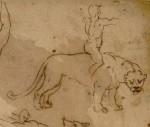 Cambridge stepped into the fray in the autumn of 2013 when art history professor emeritus Paul Joannides noticed that a page of drawings (“Sheet of studies with the Virgin embracing the Infant Jesus” now in the Musée Fabre in Montpellier) done in 1508 by an apprentice of Michelangelo’s copying his master’s works featured a drawing of a male nude astride a panther. To investigate further, Joannides collaborated with Fitzwilliam curator Victoria Avery, conservation experts Robert van Langh and Arie Pappot from the Rijksmuseum in Amsterdam, Warwick University Medical School anatomy professor Peter Abrahams, art historian Charles Avery, Verrocchio specialist Andrew Butterfield and art critic Martin Gayford.
Cambridge stepped into the fray in the autumn of 2013 when art history professor emeritus Paul Joannides noticed that a page of drawings (“Sheet of studies with the Virgin embracing the Infant Jesus” now in the Musée Fabre in Montpellier) done in 1508 by an apprentice of Michelangelo’s copying his master’s works featured a drawing of a male nude astride a panther. To investigate further, Joannides collaborated with Fitzwilliam curator Victoria Avery, conservation experts Robert van Langh and Arie Pappot from the Rijksmuseum in Amsterdam, Warwick University Medical School anatomy professor Peter Abrahams, art historian Charles Avery, Verrocchio specialist Andrew Butterfield and art critic Martin Gayford.
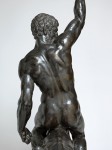 The team looked into every aspect of the bronzes. Oxford University scientists confirmed using thermoluminescence dating that the statues were cast between 300 and 500 years ago. The Rijksmuseum conservators sent samples from the bronzes’ cores to a neutron imaging lab in Switzerland which found that the thick walls of bronze were typical of 16th century Florentine casting. Dr. Abrahams’ examination of the nudes’ bodies found them anatomically correct down to the peroneal tendon and the transverse arch of the foot. He also found the anatomical detail of the nudes — navels, back grooves, abs
The team looked into every aspect of the bronzes. Oxford University scientists confirmed using thermoluminescence dating that the statues were cast between 300 and 500 years ago. The Rijksmuseum conservators sent samples from the bronzes’ cores to a neutron imaging lab in Switzerland which found that the thick walls of bronze were typical of 16th century Florentine casting. Dr. Abrahams’ examination of the nudes’ bodies found them anatomically correct down to the peroneal tendon and the transverse arch of the foot. He also found the anatomical detail of the nudes — navels, back grooves, abs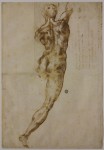 — corresponded exactly with features from other Michelangelo sculptures and preparatory drawings from 1500-1510.
— corresponded exactly with features from other Michelangelo sculptures and preparatory drawings from 1500-1510.
The investigation is ongoing, but the findings thus far are strong enough to undergird an attribution to the young Michelangelo, made after he completed the David in 1504 and as he began work on the ceiling of the Sistine Chapel. The final report of the research team will be presented at a conference on July 6th of this year. The bronzes will be on display in the Italian galleries at the Fitzwilliam Museum from February 3rd through August 9th. There’s a book detailing the research on the figures available at the museum gift shop.